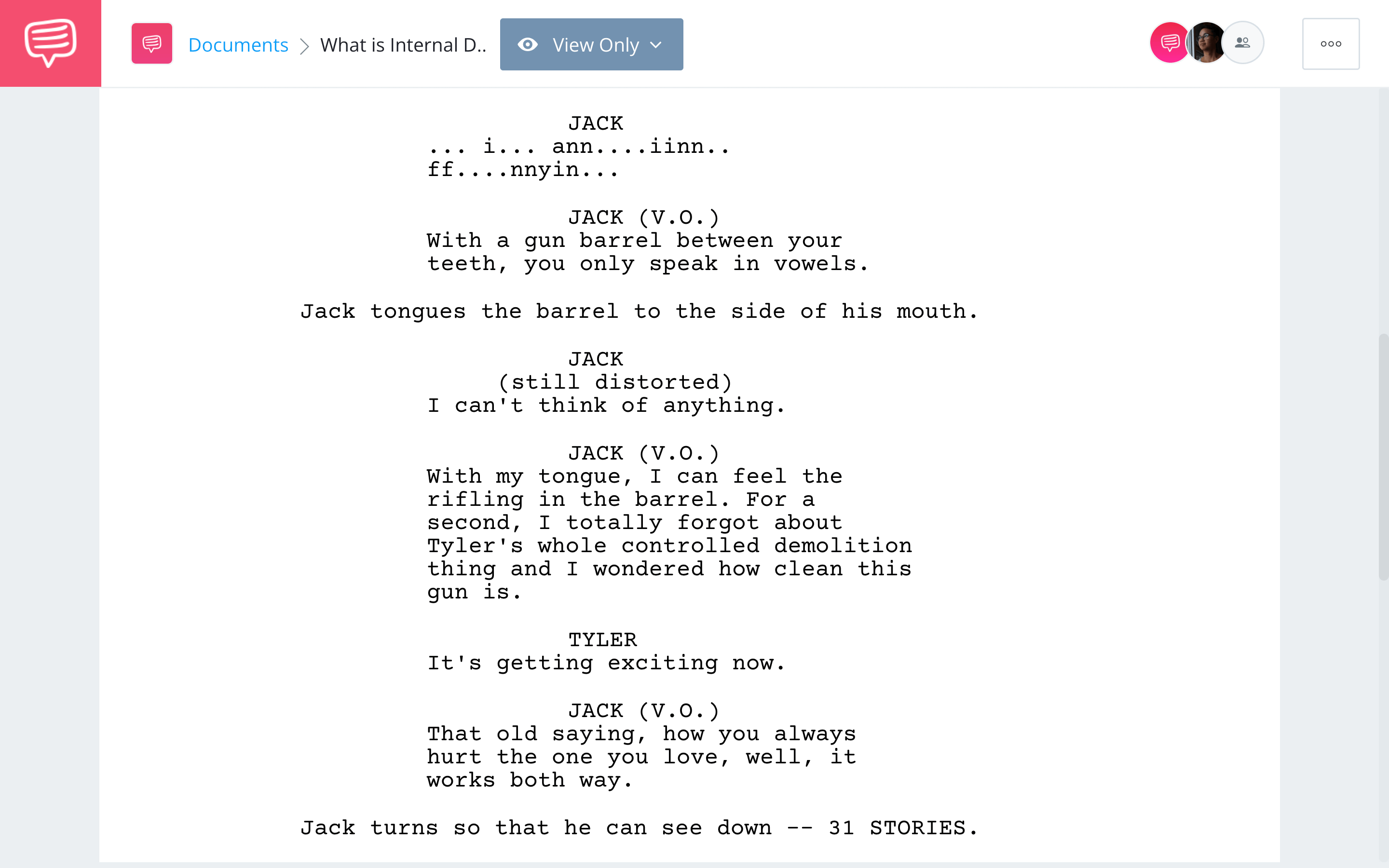Internal dialogue is one way writers communicate the inner-thoughts of their characters – but what is internal dialogue? I should say something like worry not, okay – worry not! I will explain internal dialogue with examples from American Psycho, Seinfeld, and more. By the end, you’ll know how to implement internal dialogue in prose and script format!
What Does Internal Dialogue Mean?
Background on inner dialogue
Internal dialogue may be used in storytelling – but it’s actually rooted in the psychological principle of “internal monologue.” What is internal monologue? Well, it’s basically the voice we hear when reading or thinking. It differs from internal dialogue in that it doesn’t necessarily talk to us, but rather mentally articulates what we’re sensing in a processable fashion.
This next quick video examines “inner voices” by looking at scientific analysis of verbal, pattern, and visual thinkers.
Inner Dialogue Meaning • Do You Have an Inner Voice? By BrainCraft
Internal dialogue is a conversational extension of internal monologue. So, without further ado, let’s outline an internal dialogue definition.
INTERNAL DIALOGUE DEFINITION
What is internal dialogue?
Internal dialogue is a person or character’s inner voice. In storytelling, internal dialogue serves the role of communicating unspoken thoughts and feelings to the audience. Internal dialogue is communicated differently in script and prose format.
What is Internal Dialogue in Writing?
How to show internal dialogue in writing
Inner dialogue is formatted differently in script and prose format. First, let’s break down an internal dialogue example in script format.
We imported the Fight Club screenplay into StudioBinder’s screenwriting software to see how internal dialogue is written. Click the image below to read the entire scene as scripted.
As you’re reading, think about how the scene moves between voice over (V.O.) dialogue, and normal “live” dialogue.
What is Inner Dialogue? • Read Internal Dialogue Example in The Fight Club Screenplay
In this scene, the V.O. lines are meant to communicate Jack’s inner dialogue. Notice how Jack ponders his situation with the V.O. lines? That’s because writers Chuck Palahniuk and Jim Uhls wanted us to hear his inner voice. Through this, Jack is indirectly characterized.
If you want to implement inner dialogue in a screenplay, simply add V.O. next to the character name in the dialogue section. But remember: all inner dialogue is V.O., but not all V.O. is inner dialogue. For example, Sir David Attenborough narrating nature documentaries is not inner dialogue.
There are some who would disagree, but likewise, the act of Zack Morris and Frank Underwood breaking the fourth wall should not be considered inner dialogue. Why? Because they are externalizing their inner voice.
Frank Underwood Monologue • Inner Dialog vs Monolog Example
This next example, from Fyodor Dostoevsky’s Crime and Punishment, shows how to write internal dialogue in the third person point of view.

"'I want to attempt a thing like that and am frightened by these trifles,’ he thought, with an odd smile."
Alternatively, inner dialogue may be expressed in the form of italics like this:

"'I want to attempt a thing like that and am frightened by these trifles, he thought, with an odd smile."
Inner dialogue looks a bit different from the first person point of view.
Take this example from Bret Easton Ellis’s American Psycho:

“On my way into the Chinese cleaners I brush past a crying bum, an old man, forty or fifty, fat and grizzled, and just as I’m opening the door I notice, to top it off, that he’s also blind and I step on his foot, which is actually a stump, causing him to drop his cup, scattering change all over the sidewalk. Did I do this on purpose? What do you think? Or did I do this accidentally?”
Here, Patrick Bateman relays his inner monologue in the first-person point of view via stream of consciousness. Studying American Psycho as a lesson in grammar is an exercise in insanity. That said, certain sections make for great teaching material.
If you’ve seen the American Psycho movie, you know Patrick Bateman loves inner dialogue. Check out our video essay and complete breakdown of the famous “business card” scene below! Bateman guides us through the scene, through his eyes, and through his demented and critical thoughts.
Internal Dialogue Examples American Psycho Business Card Scene • Subscribe on YouTube
Here, Bale’s V.O. serves to communicate Bateman’s obsessions. The inner dialogue is utterly essential to the scene and Bateman’s character.
How to Write Through Dialogue
Inner dialogue in drama & comedy
Internal dialogue is used as an effective tool for drama and comedy. Let’s break down a couple examples (don’t worry if you’re not familiar with the franchises, you’ll still be able to get their significance without understanding the plot).
In this example from Dragon Ball Z, Vegeta laments the power of his rival Goku; inner dialogue is used as the tool through which drama is articulated.
Internal Dialogue Examples • Vegeta’s Respect for Goku in Dragon Ball Z
Vegeta doesn’t tell Goku he respects him, but rather, the writers use internal dialogue to show he respects him. This strategy is incredibly effective at connecting characters to the audience without forcing characters to connect with each other.
Inner dialogue is also used comedically. This example from Seinfeld shows Elaine’s inner self dialogue as she travels on the train.
Internal Dialogue Writing • Elaine’s Inner Thoughts in Seinfeld
The fact that Elaine is restraining herself from externalizing her inner thoughts is what makes the scene comedic. If you want to implement internal conversation in a comedic way, consider putting your character(s) in an uncomfortable situation where they’re desperately trying to not explode.
Up Next
What is an Aside?
Internal dialogue is a perfect tool for showing the audience the inner voice of characters. But are there other tools for delivering the inner voice of characters? Indeed there is; an aside is one of them! In our next article, we break down the art of the aside with examples from Les Miserables, The Big Short, and more. By the end, you’ll know how to recognize and write asides.

